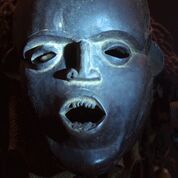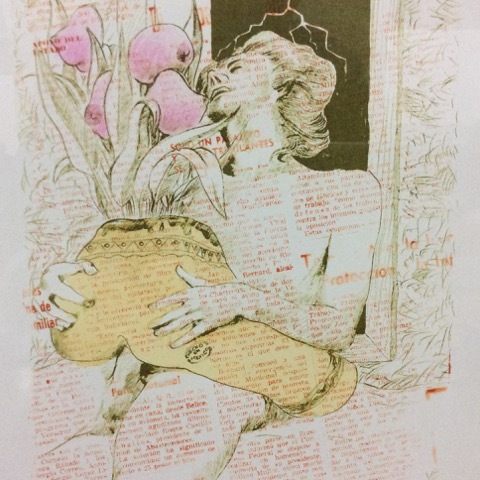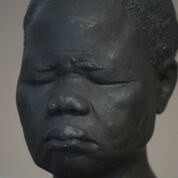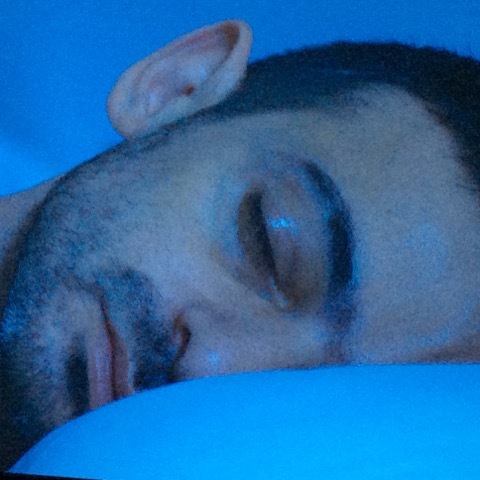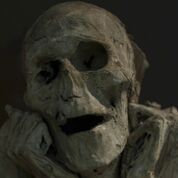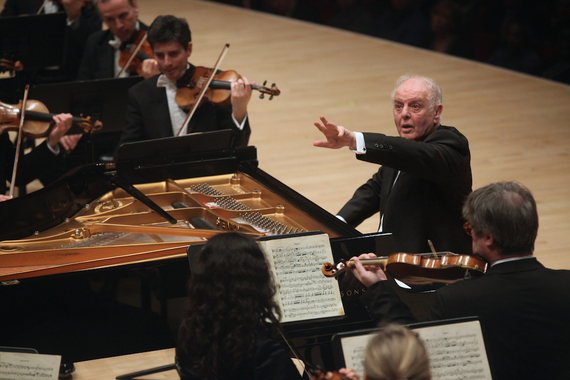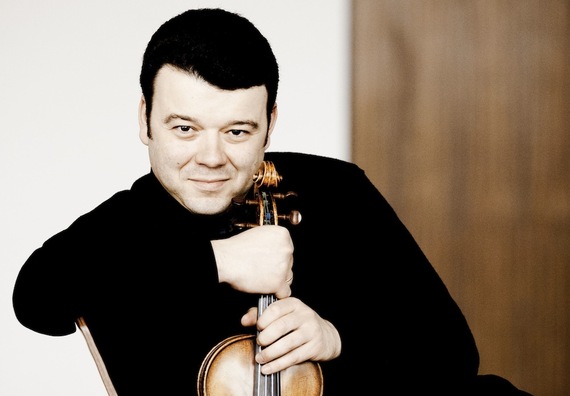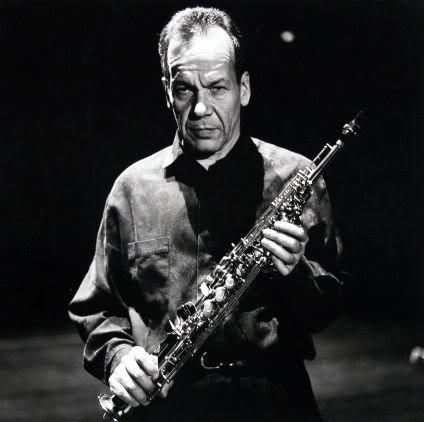![2017-02-07-1486502761-7034233-FrenchSelmerHighpitchSopranoSaxophoneOnePieceStraightBFlatSaxeTopMusicalInstrumentBlack.jpg]()
The soprano Saxophone has been the stepchild to its large brothers, the Alto and Tenor saxophones in jazz music. Despite a lineage that dates to the early twenties, the soprano was not widely used as a solo instrument in many early jazz recordings, with most soloists preferring the clarinet for its warmer, richer sound. The soprano is typically found as a straight barreled instrument although small curved horns that look like baby alto saxophones with a straighter crook are also in use. The saxophone was invented by Adolphe Sax in 1846. Modern soprano instruments have a range of between Ab3 to E6 pitched one octave higher than the tenor, but some skilled players can play in the altissimo register allowing them to play even higher.
![2017-02-07-1486502801-4191493-SidneyBechet.jpg]() Sidney Bechet photo credit unknown
Sidney Bechet photo credit unknown
It has been said that the great Sidney Bechet, a New Orleans born classically trained musician, discovered a quality soprano saxophone while on tour in England with Marion Cook's Southern Syncopated Orchestra, sometime around 1920. Bechet, who was a world class clarinetist, wanted a solo instrument that could better stand up to the louder brass cornets and trombones of the era. In the soprano, he found that the bright, piercing sound of the instrument had the strong, clear voice he was looking for and people started to notice. Bechet is considered by many to be the father of the soprano saxophone in jazz. While certainly the most celebrated player of his era, he was not the only practitioner of this quirky horn back in the twenties. The first record that I found featuring Bechet on a serpentine soprano solo was from Clarence Williams Blue Five recording of "Wild Cat Blues" recorded on July 23, 1923 in NYC. Boyd Atkins was famously heard several years later playing a momentous soprano saxophone solo while with Louis Armstrong and his Stompers on "Chicago Breakdown" from 1927. Duke Ellington would sometimes use multi- reed players Johnny Hodges and Otto Hardwick to play soprano as a section instrument in his orchestra, but on occasion the soprano was featured as a solo instrument as with Johnny Hodges beautiful work on "Harmony in Harlem" from 1937.
![2017-02-07-1486502868-2326394-luckythompson3soprano.jpg]() Lucky Thompson photo credit unknown
Lucky Thompson photo credit unknown
By the nineteen forties the premier practitioner of the soprano was the inimitable multi-reedist Lucky Thompson. You can hear some of his brilliant work while he was in Paris back in October 1940 on a session where he recorded the sensuous "Lover Man." Thompson became disenchanted with the music business in the United States and moved to Paris from 1957-1962. It was after all Paris that had so thoroughly embraced Sidney Bechet in the early twenties both because of his musicianship and because Bechet's Creole heritage had ties to the French language and to French colonialism in hometown of New Orleans. It was here that Thompson, though predominantly known as a tenor player, became more interested in the soprano and would continue to pioneer its use in more modern jazz. You can hear the man's brilliant command of this difficult instrument on such tunes as Ellington's "In a Sentimental Way" from his 1964 album
Lucky Strikes.
By the late fifties and into the sixties another young saxophonist was starting to go his own way on the instrument, abandoning his Dixieland roots and focusing exclusively on the high register horn with a more modern approach. Saxophonist Steven Norman Lackritz aka Steve Lacy is perhaps best known as the soprano's modern-day Sidney Bechet. His debut album was aptly titled
Soprano Sax and was recorded in 1957. After playing with Thelonious Monk he became enamored with the quirky pianist's compositions and rarely performed or recorded without including at least one Monk tune in his repertoire. Lacy also adventured into the avant-garde and the experimental music scene. His work and the work of saxophonist John Coltrane on the soprano would influence legions of players that followed.
![2017-02-07-1486502926-1005022-5ec28cb26f055e316be38117cb4f4.jpeg]()
Steve Lacy photo credit unknown
Reportedly Miles Davis purchased a soprano for his saxophonist at the time John Coltrane, while the group was on tour in Europe in March of 1960. Coltrane started progressively using the straight horn and he soon after broke from Davis to form his own group with McCoy Tyner on piano, Steve Davis on bass and Elvin Jones on drums. At that time only Steve Lacy was actively utilizing the instrument in jazz. The instrument had little reach outside its limited use in the world of jazz until saxophonist John Coltrane made his ground-breaking album
My Favorite Things using his soprano. The adventurous Coltrane made the soprano soar on this modal exploration of a Rogers and Hammerstein song from the Broadway show
The Sound of Music. The song was transformed into a hypnotically driven, raga inspired chant whose melody was immediately familiar despite its wildly exploratory improvisational forays over a repeated vamp. It became an instant hit and a vital bridge to an expanding non-jazz audience. It also opened the doors for many future players to explore the transcendental, eastern inspired sound of this unique instrument. The multi-instrumentalist ( not yet Rahsaan) Roland Kirk played a manzello quite proficiently. The manzello is a King saxello soprano saxophone with an extended bell. Kirk made his statement on the instrument in the late sixties with his "A Handful of Fives."
Since Coltrane, world and jazz music has seen a proliferation of players who have taken the instrument down new and unexpected paths. When fusion came on the scene in the early seventies, mixing the bombast of rock with the improvisational bravado of jazz, the soprano found its way into the music. Saxophonist's like Pharaoh Sanders, a Coltrane disciple, took the music into a spiritual mode allowing us all to "Astral Travel" with or without the aid of hallucinogens from his 1971 album
Thembi.
Multi-reed players who mostly played tenor would occasionally feature their soprano skills throughout their careers. Notable players like Zoot Sims, who came to the soprano relatively late in his career, did a beautiful version of "Moonlight in Vermont" from his 1976 album
Soprano Sax. The masterful Jerome Richardson was no stranger to the soprano and his work can be heard from the early fifties into the late nineties on such big bands as the Mingus Big Band and Oliver Nelson's Big Band. His work is represented here as a featured solist in the Thad Jones/Mel Lewis Orchestra on the song "The Waltz You Swang for Me" from the 1968 live at the Village Vanguard recording. At the same time Bechet devotees like Bob Wiber and Kenny Davern would keep the Dixieland spirit of the old master alive, although admittedly modernized, with songs like "Song of Songs" a dueling soprano performance from 1977.
No list of soprano masters would be complete without the extraordinary work of the great Wayne Shorter. His legionnaire work with his band Weather Report and on his own solo efforts are trailblazingly beautiful. Perhaps one of his most memorable performances for me was "Beauty and the Beast" from his seminal album
Native Son from 1974.
Other notable soprano players included Dave Liebman, Joe Farrell, Gerry Niewood, Joshua Redman, John Lurie, Jane Ira Bloom, Jane Bunnett, Jan Gabarek, John Surman, Klaus Doldinger, Kenny Garrett, Steve Wilson, Sonny Fortune, Dick Oatts, Billy Drewes, Bob Sheppard, Chris Cheek, Chris Potter, James Carter, Jeff Coffin and Paul Mc Candless. The saxophonist Branford Marsalis has become a superb player on the soprano and has distinguished himself from a fine field of newer players. The avant-garde modernist Evan Parker has carved himself his own place with a sound like no other. The inimitable Sam Newsome is in a class by himself having taken the instrument into new areas of sonic experimentation and texture.
In the field of popular crossover, soprano saxophonists that come to mind are Grover Washington Jr, Bob Mintzer of the Yellowjackets, and Jay Bechinstein of Spyro Gyra, and in the smooth jazz arena there is Dave Koz, Najee and of course Kenny G to name a few. Amazingly it is Kenny G's soprano saxophone on "Going Home" that has probably been the most played song on the instrument in its history! It is often used in China, even twenty-five years after it was recorded, to signal to shoppers that it is closing time and indeed time to go home.
I could not have assembled such a well studied list without the generous help of saxophonist, arranger and educator Bill Kirchner, multi-reedist Scott Robinson, and saxophonists Michael Blake and Dave Anderson. To them I offer my sincerest thanks. With the above brief history, and acknowledging in advance to having undoubtedly left off some important players whom I may not be aware of, here are my picks for twenty-five great jazz soprano saxophone performances in roughly chronological order:
Sidney Bechet "Wild Cat Blues" from
Clarence Williams Blue Five; Sidney Bechet, sop sax; Clarence Williams, piano; Thomas Morris, cornet; John Mayfield, trombone; Buddy Christian, banjo. Recorded in NYC 1923
Boyd Atkins: "Chicago Breakdown" from
Louis Armstrong and His Stompers with Louis Armstrong, trumpet; Boyd Atkins, sop sax; Frank Walker, baritone sax; Rip Bassett, banjo/guitar; Earl Hines, piano; Albert Washington, tenor sax; Honore Dutry, trombone; Bill Wilson, cornet; Tubby Hall drums. Recorded in Chicago, Illinois 1927
Johnny Hodges: "Harlem in Harmony" with
the Duke Ellington Orchestra recorded in September 20, 1937 in NYC with Johnny Hodges , sop sax; Duke Ellington, piano; Rex Stewart, cornet; Cootie Williams, Arthur Whetsel, Freddie Jenkins, trumpets; Joe Nanton, Lawrence Brown, trombones; Juan Tizol valve trombone; Barney Bigard, clarinet; Otto Hardwick, alto and clarinet; Harry Carney, baritone sax; Freddy Guy, guitar; Billy Taylor, bass, Sonny Greer, drums.
Steve Lacy : "Day Dream" from the album
Soprano Sax recorded November 1, 1957 at Van Gelder studios in Hackensack , NJ with Wynton Kelly, piano; Buell Neidinger, bass; Dennis Charles, drums.
Lucky Thompson: "In A Sentimental Mood" from his album
Lucky Strikes recorded September 15, 1964 at Van Gelder Studios in Hackensack, NJ with Lucky Thompson, sop sax; Hank Jones, piano; Richard Davis, piano; Connie Kay , drums.
John Coltrane: "My Favorite Things" for his album
My Favorite Things recorded October 21,24 and 26th 1960 with John Coltrane, sop sax; McCoy Tyner, piano; Steve Davis, bass; Elvin Jones, drums.
Rahsaan Roland Kirk: "Handful of Fives" from his album
The Inflated Tear recorded November 27-31, 1967 with Roland Kirk, manzello; Ron Burton, piano; Steve Novosel, bass; Jimmy Hopps, drums; Dick Griffin, trombone.
Jerome Richardson: "The Waltz You Swang for Me" from his work on the album
Monday Night Thad Jones/Mel Lewis Orchestra live at the Village Vanguard album from October 1968 recorded at the Village Vanguard in NYC with Jerome Richardson, sop sax; Richard Davis , bass; Thad Jones, flugelhorn; Mel Lewis, drums, Roland Hanna, piano; Jerry Dodgian, alto sax; Seldon Powell, tenor sax; Eddie Daniels, tenor sax; Pepper Adams, baritone sax; Richard Williams, SnookyYoung, Danny Moore, Jimmy Nottingham, trumpets; Jimmy Knepper, Garnet Brown, Jimmy Cleveland, Cliff Heather, trombones.
Pharaoh Sanders: "Astral Traveling" from his album
Thembi recorded November 1970 and January 1971 in California with Pharoah Sanders sop sax; Lonnie Liston Smith, Fender Rhodes; Michael White, violin; Cecil McBee, bass; Clifford Jarvis, drums.
Dave Liebman, Joe Farrell and Steve Grossman: "Brite Piece" from Elvin Jones
Merry Go Round recorded Feb 12, and December 16, 1971 at Van Gelder Studios, Engelwood Cliffs, NJ with Dave Liebman, Joe Farrell and Steve Grossman, sop saxes; Elvin Jones, drums, Gene Perla, bass; Jan Hammer, electric piano; Don Alias, oriental bells.
Here is a live performance of the group in France in 1972 unfortunately without the great Joe Farrell or Don Alias, and with Steve Grossman on tenor.
Joe Farrell: "La Fiesta" from Chick Corea's
Return to Forever recorded February 2nd & 3rd, 1972 in London with Joe Farrell, sop sax; Chick Corea, electric piano; Stanley Clarke, bass; Airto Moreira, drums and percussion; Flora Purim , vocals and percussion; "La Fiesta" starting at 38:00 minute mark
Grover Washington Jr.: "Invitation" from a live broadcast on WBCN in Boston, Mass in Spring of 1973 with Grover Washington Jr., sop sax; Bill Meek, Fender Rhodes; Charles Fambrough, bass; Daryl Brown, drums.
Wayne Shorter: "Beauty and the Beast" from his album
Native Son recorded in 1974 with Wayne Shorter, sop sax; Milton Nascimento, vocals; David Amaro, guitar; Jay Graydon, bass; Herbie Hancock, piano and keyboards; Wagner Tiso, organ; Dave McDaniel, bass; Roberto Silva, drums; Airto Moreira, percussion.
Zoot Sims: "Moonlight in Vermont" from his album
Zoot Sims- Soprano Sax recorded January 8th and 9th 1976 at RCA Studios NYC with Ray Bryant, piano; George Mraz, bass; Grady Tate, drums.
Bob Wilber and Kenny Davern: "Song of Songs" from a live performance in October 1977 with Bob Wilber curved bell sop sax; Kenny Davern, straight sop sax; Bucky Pizzarelli, guitar; Geroge Duvivier, bass; Bobby Rosengarten, drums.
Gerry Niewood: "Joy" from his album Gerry Niewood and Timepiece from 1976 with Gerry Niewood, sop sax; Dave Samuels, electric vibes; Rick Laird, bass; Ron Davis, drums.
Klaus Doldinger: "Ataraxia Part 1 and 2" from the album by his group
Passport Ataraxia recorded in Germany 1978 with Klaus Doldinger sop sax and keyboards; Dieter Petereit, bass; Willie Ketzer, drums; Roy Louis, guitars; Hendrik Schaper, keyboards; Elmer Louis, percussion.
Dick Oatts: "Ding Dong Ding" from the
Mel Lewis and the Jazz Orchestra with Bob Brookmeyer recorded live at the Village Vanguard 1980 with Dick Oatts sop sax; Jim McNeely, piano; Rufus Reid, Bass; Mel Lewis, drums; Bob Mintzer, Steve Coleman, Gary Pribeck, Richard Perry, reeds; Bob Brookmeyer, trombone and arranger; Earl McIntyre, John Mosca, Lee Robertson, Lolly Bienenfeld, trombones; Earl Gardner, Larry MosesRon Tooley, trumpets; Stepahnie Fauber, French horn.
Jane Ira Bloom: "The Man with the Glasses" from her album
Mighty Lights recorded at Vanguard Studios in NYC November 17 and 18, 1982 with Jane Ira Bloom, sop sax; Charlie Haden, bass; Fred Hersch, piano; Ed Blackwell, drums.
Chris Cheek: "Ice Fall" from his album
Vine recorded 1999 with Chris Cheek , sop sax; Brad Mehldau, electric piano, Kurt Rosenwinkel, guitar; Matt Penman, bass; Jorge Rossy, drums.
Sam Newsome: "Toy Tune" from the Orrin Evans Album
Grown Folk Bizness released in Oct 1999 with Sam Newsome, sop sax; Orrin Evans, piano; Rodney Witaker, bass; Ralph Peterson, drums.
Branford Marsalis: "The Ruby and the Pearl" from his album
Eternal recorded October 7-10th, 2003 with Branford Marsalis, sop sax; Joey Calderazzo, piano, Eric Revis Bass, Jeff "Tain" Watts, drums.
Paul McCandless: "May or Mai" live in concert with Antonio Calogero in Messina, Italy on November 28, 2007 with Paul McCandless, sop sax; Antonio Calogero, classical guitar.
Kenny Garrett: "Detroit" from
Seeds from the Underground released April 2012 with Kenny Garrett, sop sax; Benito Gonzales, piano; Nat Reeves, bass, Rudy Bird Percussion; Ronald Bruner drums; Nedelka Prescod, vocal.
Jan Gabarek: live at Mai Jazz Festival in Stvanger Cocnert in Norway, 2013 with Jan Gabarek, sop sax; Rainer Brǘninghaus, keyboards; Trilok Gurtu, drums; Youri Daniel , bass.
You may also like to check out my
Twenty-Five Great Jazz Baritone Performances
by clicking
here. Or if your into jazz flute my
Twenty-Five Great Jazz Flute Perfromances by clicking
here. -- This feed and its contents are the property of The Huffington Post, and use is subject to our terms. It may be used for personal consumption, but may not be distributed on a website.


 Tyne Daly; courtesy of York Theatre
Tyne Daly; courtesy of York Theatre